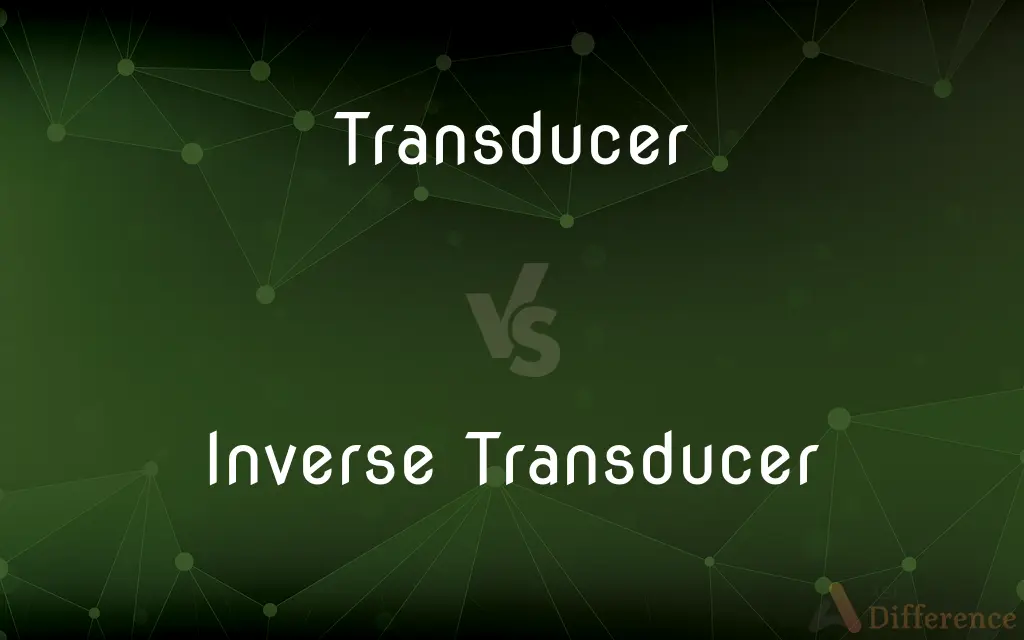Transducer vs. Inverse Transducer — What's the Difference?
By Tayyaba Rehman — Published on January 23, 2024
A transducer is a device that converts one form of energy into another. An inverse transducer is a specific type of transducer that typically converts electrical signals into physical energy.

Difference Between Transducer and Inverse Transducer
Table of Contents
ADVERTISEMENT
Key Differences
A transducer is a general term for any device that converts energy from one form to another, such as a microphone converting sound waves into electrical signals. An inverse transducer does the opposite, converting electrical signals into another form of energy, like a speaker converting electrical signals into sound.
Transducers are integral in various applications, including sensors and measurement devices, where they convert physical properties like pressure or temperature into readable electrical signals. Inverse transducers are commonly used in output devices, like actuators or speakers, where they transform electrical signals into motion or sound.
The functionality of a transducer is based on the principle of energy conversion, which can be mechanical, electrical, acoustic, electromagnetic, or thermal. Inverse transducers often focus on electromechanical conversion, turning electrical energy into mechanical movement or sound.
In terms of application, standard transducers are used in systems for sensing and monitoring, while inverse transducers are used in systems where human interaction or response is needed, such as in audio systems or haptic feedback devices.
Transducers can be passive or active, depending on whether they require an external power source. Inverse transducers, particularly those like loudspeakers, typically require an external power source to function effectively.
ADVERTISEMENT
Comparison Chart
Energy Conversion
Converts various forms of energy to electrical signals
Converts electrical signals to other forms of energy
Applications
Used in sensors, measurement devices
Used in output devices like speakers, actuators
Principle
Can involve mechanical, acoustic, electromagnetic conversions
Often involves electromechanical conversion
Use Case
Sensing and monitoring
Human interaction, response systems
Power Requirement
Can be passive or active
Typically requires external power
Compare with Definitions
Transducer
Can be found in microphones, sensors.
Microphones are transducers that convert sound into electrical signals.
Inverse Transducer
Converts electrical signals into physical energy.
Speakers are inverse transducers converting electrical audio signals into sound.
Transducer
Operates based on energy conversion principles.
Transducers in medical ultrasound machines convert electrical signals into sound waves.
Inverse Transducer
Commonly used in speakers, actuators.
The actuator is an inverse transducer that moves machine parts using electrical signals.
Transducer
Used in various sensing applications.
This transducer in the thermostat measures room temperature.
Inverse Transducer
Often used for human-machine interaction.
Haptic feedback devices use inverse transducers for tactile responses.
Transducer
Converts energy from one form to another.
The pressure sensor is a transducer converting pressure into an electrical signal.
Inverse Transducer
Involves electromechanical energy conversion.
In this robotic arm, inverse transducers convert electrical signals into mechanical movements.
Transducer
May require external power for operation.
Active transducers in this system require an external power source.
Inverse Transducer
Typically requires an external power source.
This inverse transducer in the audio system needs power to operate effectively.
Transducer
(Physics) A substance or device, such as a piezoelectric crystal, microphone, or photoelectric cell, that converts input energy of one form into output energy of another.
Transducer
A device that converts energy from one form into another.
Transducer
(computing theory) A state machine that generates output based on a given input.
Transducer
An electrical device that converts one form of energy into another
Common Curiosities
Can a transducer be both a standard and inverse type?
Some devices can function as both, depending on their application and design.
What is an inverse transducer?
A transducer that converts electrical signals into another form of energy, like sound or motion.
What is an example of an inverse transducer in robotics?
Actuators in robots that convert electrical signals into mechanical movements.
What is a transducer?
A device that converts one form of energy into another.
Do all transducers need external power?
Active transducers require external power, while passive ones do not.
Are there transducers in smartphones?
Yes, smartphones contain several transducers, like microphones and vibration motors.
Is a microphone a transducer or an inverse transducer?
A microphone is a transducer, converting sound waves into electrical signals.
Can inverse transducers be used in safety systems?
Yes, especially in systems requiring immediate physical response like automatic braking in vehicles.
Where are transducers commonly used?
In sensors, medical devices, microphones, and various measurement tools.
Are speakers considered inverse transducers?
Yes, speakers are inverse transducers converting electrical audio signals into sound.
Do transducers play a role in environmental monitoring?
Yes, they are used in devices that monitor environmental parameters like temperature and pressure.
Can inverse transducers generate heat?
Some inverse transducers can generate heat as a by-product of their operation, particularly in high-power applications.
How do transducers impact everyday technology?
They are essential in converting physical quantities into signals that technology can interpret and use.
How important are inverse transducers in audio technology?
Inverse transducers like speakers and headphones are crucial in converting electrical signals into audible sound.
What kind of energy do transducers typically convert?
They can convert mechanical, thermal, acoustic, and electromagnetic energy.
Share Your Discovery

Previous Comparison
Roomba iRobot 670 vs. Roomba iRobot 675
Next Comparison
Sunmica vs. PVC MicaAuthor Spotlight
Written by
Tayyaba RehmanTayyaba Rehman is a distinguished writer, currently serving as a primary contributor to askdifference.com. As a researcher in semantics and etymology, Tayyaba's passion for the complexity of languages and their distinctions has found a perfect home on the platform. Tayyaba delves into the intricacies of language, distinguishing between commonly confused words and phrases, thereby providing clarity for readers worldwide.












































